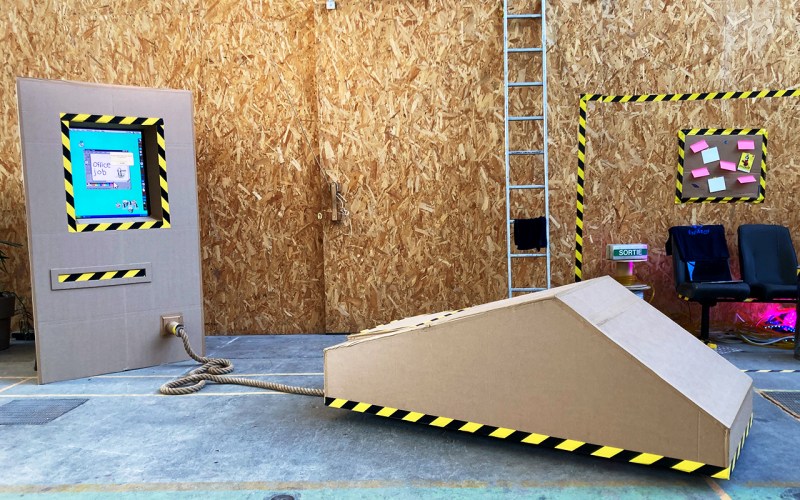Computer mice come in all kinds of shapes and sizes, but are typically designed to fit in the palm of your hand. While some users with large hands may find standard mice uncomfortably small, we don’t think anyone will ever make that complaint about the humongous peripheral [Felix Fisgus] made for a game called Office Job at the ENIAROF art festival in Marseille. With a length of about two meters we suspect it might be the largest functional computer mouse in existence.
 Inside the massive mouse is a wooden pallet with four caster wheels that enable smooth movement in all directions. This motion is detected by an ordinary optical mouse sensor: perhaps surprisingly, these can be used at this enormous scale simply by placing a different lens in front.
Inside the massive mouse is a wooden pallet with four caster wheels that enable smooth movement in all directions. This motion is detected by an ordinary optical mouse sensor: perhaps surprisingly, these can be used at this enormous scale simply by placing a different lens in front.
As for the mouse button, [Felix] and his colleagues found of that the bottom of an empty five-liter can has a nice “pop” to it and installed one in the front section of the device, hooked up to an ESP32 board that communicates with a computer through Bluetooth.
The mouse connects to an equally huge desktop computer, powered by a Raspberry Pi, on which users play a game that involves clicking on error messages from a wide variety of old and new operating systems. Moving the mouse and pressing its button to hit those dialog boxes is a two-person job, and turns the annoyance of software errors into a competitive game.
Optical mouse sensors are versatile devices: apart from their obvious purpose they can also serve as motion sensors for autonomous vehicles, or even as low-resolution cameras.
















I never imagined closing popups could be fun. Great job!
Going to resurrect a joke here:
My suggestion for the name is Human-Interface Device Of Unusual Size – or HIDeOUS.
I don’t believe they exist.
From the original project:
> The computer case was also built mostly from cardboard and housed a fortyish-inch plasma screen, which was turned by 90° so it better resembles the well known portrait format from old computer-screens.
Yes, because so many of the computers whose dialogue boxes were depicted used portrait screens…
Ignoring the arcade game machines and the Vectrex… about the only one that comes to mind as being portrait was the Xerox Alto. Pretty much every IBM clone, Apple Mac and common Unix system universally used a landscape format.
I agree, “well known portrait format” is far from reality. But Xerox Alto is not the only one, Apple had portrait monitor for Macintosh somewhere in the late 80s. Macs were popular for publishing at the time, and portrait monitor could show entire page.
Anyway, this project looks like a lot of fun. :-)
Reminds me of VVS, the Vertical Video Syndrome.
https://m.youtube.com/watch?v=f2picMQC-9E
Users of smartphones are often affected.
Currently, only PC use over a longer period cures it.
Na, just kidding. It’s just a joke, isn’t it?